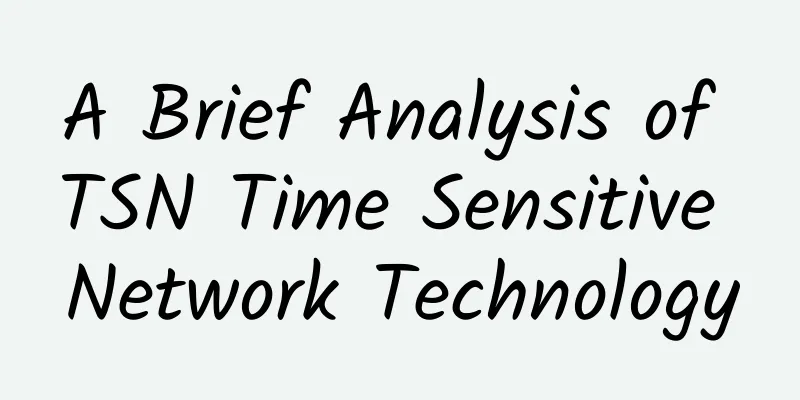A Brief Analysis of TSN Time Sensitive Network Technology

|
With the continuous development of industrial intelligence, the industrial Internet has become a key comprehensive information infrastructure for the development of industrial intelligence. As the infrastructure for the development of the industrial Internet, the basic network will require more powerful interconnection, high-quality transmission and intelligent operation and maintenance capabilities in the future. Under the general trend of IT and OT integration in smart manufacturing and industrial Internet, a unified network technology solution is needed to connect the underlying basic network. The end-to-end extremely low latency and reliable data transmission of the TSN network have become the only choice for the basic network in industrial scenarios. TSN Time Sensitive NetworkTSN network is time-sensitive network, which is usually called time-sensitive network or time-sensitive network in Chinese. TSN is a layer 2 technology. The IEEE 802.1Q standard works at the second layer of OSI. TSN is an Ethernet standard, not an IP protocol standard. The forwarding decision made by the TSN bridge is based on the content of the Ethernet header, not the IP address. The payload of the Ethernet frame can be anything, not limited to the IP protocol. It is actually a set of "sub-standards" based on the framework of IEEE 802.1 to meet special needs. Rather than saying that TSN is a new technology, it is better to say that it is an improvement on the existing network technology Ethernet. TSN adds key technologies such as clock synchronization, traffic scheduling and network configuration on the basis of Ethernet to provide low latency, low latency jitter and low packet loss rate transmission services for time-sensitive data. Key features of TSN time-sensitive networkTime SynchronizationTSN's traffic scheduling is based on time slots, so clock synchronization is the basis of TSN. TSN uses the Precision Time Protocol to ensure that the clocks of all network devices are consistent without having to synchronize with the natural clock. IEEE 802.1AS-2011 specifies the clock synchronization mechanism for the entire TSN network and proposes the generalized precision time protocol (gPTP). gPTP is an extension of the precision time protocol (PTP) of IEEE 1588-2008, and the two have the same working mode. Global time synchronization is the basis of most TSN standards, which is used to ensure the correct matching of data frame transmission time slots in various devices, and meet the end-to-end deterministic delay and queue-free transmission requirements of communication flows. TSN uses IEEE 802.1AS to transmit synchronization messages between various time-aware systems, further improves the synchronization protocol of Ethernet, adds synchronization of distributed networks, and adopts a two-way information channel to improve the accuracy of transmission signals. Flow ControlThe TSN flow control process mainly includes flow classification, flow shaping, flow scheduling and flow preemption. The main function of flow classification is to determine the corresponding traffic type and priority information by identifying the attribute information or statistical information of the flow. The main evaluation indicator is the classification accuracy. The main function of flow shaping is to limit the maximum rate of sending and receiving flows and cache the flows that exceed the rate, and then control the flows to be sent at a more uniform rate to achieve the purpose of stable transmission of burst traffic. The main function of flow scheduling is to schedule queued and shaped flows to the output port through certain rules (scheduling algorithms or mechanisms) to determine the corresponding forwarding order of flows in the switch, thereby ensuring the QoS requirements of various flows during transmission and reducing network congestion to a certain extent. Stream preemption changes the scheduling order of low-priority streams and ensures timely forwarding of high-priority streams. It is a special form of stream scheduling and one of the key technologies of TSN. The main function of stream preemption is to interrupt the transmission of low-priority frames through inter-frame slicing to avoid the phenomenon of stream priority inversion, so as to ensure the real-time or ultra-low latency performance requirements of high-priority frames. Network ConfigurationFor time-sensitive network applications, TSN needs to configure the transmitter, receiver, and switches in the network to provide services such as reserved bandwidth for time-sensitive data. The configuration models of time-sensitive networks defined in IEEE 802.1Qcc are divided into three types: fully centralized configuration model, hybrid configuration model, and fully distributed configuration model. Fully centralized user configuration (CUC), responsible for the configuration of the sender and receiver; centralized network configuration (CNC), responsible for the configuration of TSN switches. The fully centralized model supports the centralized user configuration (CUC) entity to discover terminals and user requirements and configure TSN features in the terminals. Figure 1. Fully centralized model The hybrid configuration model uses a centralized network configuration controller (CNC) and a distributed user configuration controller (CUC). In the centralized network/distributed model, configuration information is directed to or from the centralized network configuration (CNC) entity. Figure 2. Hybrid configuration model The fully distributed configuration model uses a distributed network configuration controller (CNC) and a distributed user configuration controller (CUC). In this mode, the terminals of the user flow directly communicate user needs through the TSN user/network protocol. The network is configured in a fully distributed manner, without a centralized network configuration entity. Figure 3. Fully distributed model TSN time-sensitive network application scenario examplesIndustrial InternetWith the continuous development of the industrial Internet, the rapid upgrading of industrial applications towards digitalization, networking and intelligence is constantly being promoted. It is necessary not only to ensure the interoperability of information, but also to ensure the data security between production equipment. The integration of IT (information technology), OT (operational technology) and CT (communication technology) has become the general trend of the development of the industrial Internet. The ultimate realization of industrial interconnection, on such an underlying basic network, can better support the new generation of factory-level, workshop-level and field-level industrial applications. TSN technical standards are mainly used in the industrial field for related protocols including IEEE 802.1AS clock synchronization, IEEE 802.1Qbv time-aware scheduler, IEEE 802.1Qcc network management and configuration, IEEE 802.1CB high reliability, IEEE 802.1Qci one-by-one stream filtering and management, etc. Autonomous drivingWith the rise of autonomous driving and the Internet of Vehicles, the large amount of data interaction between on-board devices, the diversity, complexity and high cost of traditional on-board network technologies have put forward strict requirements on the transmission bandwidth, interoperability and cost of on-board networks. At present, multiple buses still coexist independently in the in-vehicle network. Auxiliary media signals and control signals represented by audio and video are still transmitted separately on different buses, and cannot be uniformly transmitted on the same link. The reason for this is that there is a major technical difficulty here. TSN technology can improve the best-effort forwarding characteristics of traditional Ethernet. According to the different priorities of data streams, it can provide different degrees of end-to-end bounded delay guarantees and smaller jitter, etc. It can provide high-bandwidth, high-reliability, low-latency and time-synchronized audio/video streaming services on the second-layer network. These features can meet the development needs of in-vehicle networks and thus meet the application requirements of in-vehicle Ethernet. |
<<: How can domestic Wi-Fi chips make up for the "lost decade"?
>>: Self-intelligent network, intent-driven?
Recommend
Network charges are more affordable and 5G demand is gradually released
Data released recently on the official website of...
Cheng Jianjun talks about China's spectrum strategy: In the future, the allocation of high, medium and low frequency bands will be fully considered
The 2022 MWC Barcelona Conference kicked off rece...
RAKsmart cloud server starts from $1.99/month, 30% off, available in US/Hong Kong/Japan/Singapore data centers
Let's pay attention to the information of clo...
iWebFusion: Los Angeles/North Carolina dedicated servers starting at $49/month, 10Gbps bandwidth servers starting at $149/month
iWebFusion (or iWFHosting) is a relatively low-ke...
spinservers June promotion: 10Gbps server from $119/month, Dual Silver4116/64G memory/1TB NVme hard drive
spinservers has released a regular promotion for ...
Energy-saving building 5G solutions are the key to green buildings
Building equipment suppliers are prioritizing gre...
Wi-Fi signal is not good? Hybrid network architecture is a recommended choice
I’ve worked with many companies that have impleme...
What is the network VRRP protocol, and can it really solve network stability issues?
With the rapid development of the Internet, vario...
How to solve the problem that Ubuntu 18.04 cannot start normally after switching from XEN to KVM
There are fewer and fewer businesses that still u...
HostYun: Hong Kong high bandwidth VPS monthly payment starts from 18 yuan, South Korea VPS monthly payment starts from 16 yuan, Japan/Russia/Los Angeles Cera monthly payment starts from 19 yuan
Let me recommend HostYun, a long-established low-...
A new starting point: 5G messaging writes a new chapter in 2020
Currently, nearly 100 operators around the world ...
Zhao Houlin: Broadband development has made remarkable achievements, but there are still considerable challenges. The global industry needs to fully cooperate.
The digital divide has not yet disappeared, and t...
Brocade Launches New Agile Data Center Portfolio to Help Enterprises Transform Digitally
[51CTO.com original article] In 1992, Andrew Grov...
How will 5G impact the video surveillance and physical security industries?
[[407162]] It’s been a few years, but 5G (fifth g...









